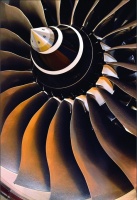Turbine of the times
A new class of intermetallic materials under development may replace superalloys in the hot sections of modern-day jet engines.

Due to the extraordinary temperature and forces they must withstand, turbine blades in the hot sections of jet engines are manufactured from a class of materials known as superalloys.
Although such superalloys have been successfully used for more than 50 years due to their outstanding mechanical properties, materials scientists are still working to improve their characteristics, enabling design engineers to develop jet engines that can operate at even higher temperatures and hence use fuel more efficiently. Even as they do so, a new class of intermetallic materials is emerging that may replace superalloys entirely.
Superalloys used in today’s aero-engine blades are metallic alloys based on nickel, the high-temperature strength of which is enhanced by adding aluminium at the melt-processing stage. As the alloys are cooled from high temperatures, a microstructure is created that consists of two main equilibrium phases – a gamma phase, as the matrix, and a gamma-prime phase as the precipitate. It is the precipitate that is largely responsible for the elevated temperature strength of the material, its resistance to creep deformation and its high oxidation resistance.
Register now to continue reading
Thanks for visiting The Engineer. You’ve now reached your monthly limit of premium content. Register for free to unlock unlimited access to all of our premium content, as well as the latest technology news, industry opinion and special reports.
Benefits of registering
-
In-depth insights and coverage of key emerging trends
-
Unrestricted access to special reports throughout the year
-
Daily technology news delivered straight to your inbox










Water Sector Talent Exodus Could Cripple The Sector
One possible reform to the Asset Management Plan (AMP) system would be to stagger the five year cycle across the ten or so water businesses, so that...